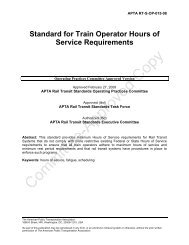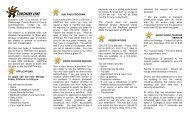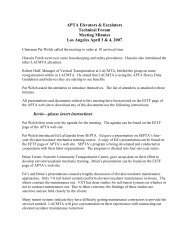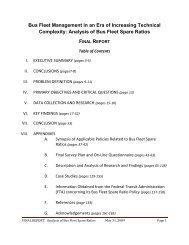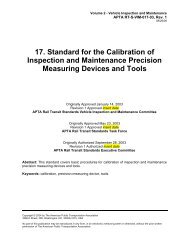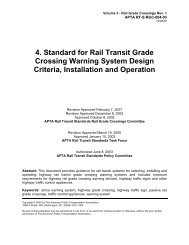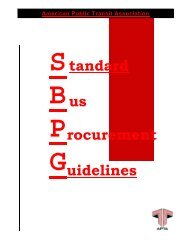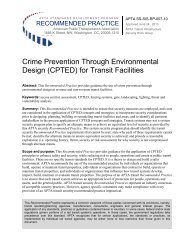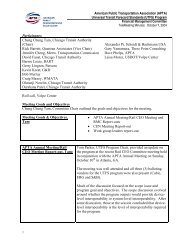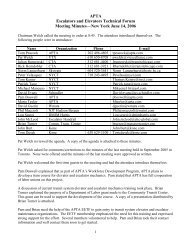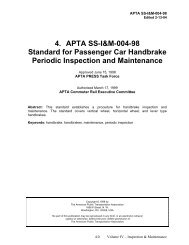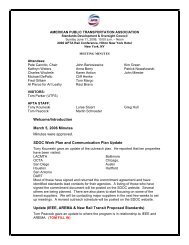APTA SS-PS-002-98, Rev. 2 Standard for Emergency Signage for ...
APTA SS-PS-002-98, Rev. 2 Standard for Emergency Signage for ...
APTA SS-PS-002-98, Rev. 2 Standard for Emergency Signage for ...
You also want an ePaper? Increase the reach of your titles
YUMPU automatically turns print PDFs into web optimized ePapers that Google loves.
<strong>APTA</strong> <strong>SS</strong>-<strong>PS</strong>-<strong>002</strong>-<strong>98</strong>, <strong>Rev</strong>. 2<br />
Edited 4-1-04<br />
2. <strong>APTA</strong> <strong>SS</strong>-<strong>PS</strong>-<strong>002</strong>-<strong>98</strong>, <strong>Rev</strong>. 2<br />
<strong>Standard</strong> <strong>for</strong> <strong>Emergency</strong> <strong>Signage</strong> <strong>for</strong><br />
Egress/Access of Passenger Rail<br />
Equipment<br />
Originally Approved June 15, 19<strong>98</strong><br />
<strong>Rev</strong>ision 2 Approved October 30, 2<strong>002</strong><br />
<strong>APTA</strong> PRE<strong>SS</strong> Task Force<br />
Authorized March 17, 1999<br />
<strong>Rev</strong>ision 2 Authorized January 11, 2003<br />
<strong>APTA</strong> Commuter Rail Executive Committee<br />
Abstract: This standard contains minimum requirements <strong>for</strong> the physical<br />
characteristics, in<strong>for</strong>mational content, and placement of emergency signs and markings<br />
<strong>for</strong> passenger rail car egress/access points on both the interior and exterior of said<br />
equipment.<br />
Keywords: instructions, luminescent, markings, photoluminescent (PL), retro-reflective,<br />
signs<br />
Copyright © 2<strong>002</strong> by<br />
The American Public Transportation Association<br />
1666 K Street, N. W.<br />
Washington, DC, 20006, USA<br />
No part of this publication may be reproduced in any <strong>for</strong>m, in an electronic retrieval<br />
system or otherwise, without the prior written permission of<br />
The American Public Transportation Association.<br />
2.0<br />
Volume VI - Passenger System
Introduction<br />
2.1<br />
<strong>APTA</strong> <strong>SS</strong>-<strong>PS</strong>-<strong>002</strong>-<strong>98</strong>, <strong>Rev</strong>. 2<br />
Edited 4-1-04<br />
(This introduction is not a part of <strong>APTA</strong> <strong>SS</strong>-<strong>PS</strong>-<strong>002</strong>-<strong>98</strong>, <strong>Rev</strong>. 2, <strong>Standard</strong> <strong>for</strong> <strong>Emergency</strong><br />
<strong>Signage</strong> <strong>for</strong> Egress/Access of Passenger Rail Equipment.)<br />
<strong>Rev</strong>iew of past passenger rail accidents involving passenger and train crew emergency<br />
evacuation has indicated that both passengers and emergency responders lacked sufficient<br />
in<strong>for</strong>mation necessary <strong>for</strong> expedient emergency egress and access due to the absence of<br />
clear markings and instructions. The lack of adequate signage in conjunction with lighting<br />
system failures and/or low levels of illumination during these accidents was cited as a<br />
cause <strong>for</strong> confusion and as a contributing factor to the injuries and casualties that resulted.<br />
The National Transportation Safety Board (NTSB) made the following recommendation<br />
to the Federal Railroad Administration (FRA) in National Transportation Safety Board<br />
Recommendation to Federal Railroad Administration, FRA R-97-17 1 after investigation<br />
of a recent passenger train accident:<br />
Issue interim standards <strong>for</strong> the use of luminescent material, retroreflective<br />
material, or both to mark all interior and exterior emergency exits in all passenger<br />
cars as soon as possible and incorporate the interim standards into minimum car<br />
standards.<br />
FRA issued a final rule revising existing glazing <strong>Standard</strong>s contained in 49 CFR Part 223<br />
and establishing minimum standards <strong>for</strong> passenger train emergency preparedness (See 49<br />
CFR Part 239). The FRA regulations require that minimum levels of emergency lighting<br />
be provided near doors and along the aisles be <strong>for</strong> new cars. In addition, <strong>for</strong> both new and<br />
existing cars, the interior location of each passenger car emergency door used <strong>for</strong><br />
emergency egress must be marked and be conspicuously visible by the use of lighting<br />
and/or luminescent marking. Each door control release mechanism must be marked on<br />
the interior and exterior with clearly visible and legible instructions. The interior location<br />
of emergency exit windows must also be clearly visible by the use of luminescent<br />
material and instructions <strong>for</strong> their use must be also be provided. If exterior window<br />
access points are provided to emergency responders, clear and conspicuous markings and<br />
instructions must be provided.<br />
This emergency signage standard specifies the minimum visual in<strong>for</strong>mation necessary <strong>for</strong><br />
use by passengers and train crew members to exit and <strong>for</strong> emergency responders to access<br />
the car under various types of extreme emergency situations that require the last-resort<br />
measure of car evacuation.<br />
This standard, taken together with the American Public Transportation Association<br />
(<strong>APTA</strong>) <strong>APTA</strong> <strong>SS</strong>-E-013-99, <strong>Standard</strong> <strong>for</strong> <strong>Emergency</strong> Lighting System Design <strong>for</strong><br />
Passenger Cars, and <strong>APTA</strong> <strong>SS</strong> <strong>PS</strong>-004-<strong>98</strong>, <strong>Rev</strong> 1, <strong>Standard</strong> <strong>for</strong> Low-Location Exit Path<br />
Marking, provides a systems approach to locate, reach, and operate emergency exits to<br />
ensure the safe evacuation of passengers and crewmembers in the event of an emergency.<br />
Railroads and car builders should carefully consider the options available to meet<br />
emergency evacuation requirements presented in these three standards.<br />
1 For references in Italics, see Section 2 of this standard.<br />
Volume VI - Passenger System
<strong>APTA</strong> <strong>SS</strong>-<strong>PS</strong>-<strong>002</strong>-<strong>98</strong>, <strong>Rev</strong>. 2<br />
Edited 4-1-04<br />
This revision of the standard includes a Table of Contents, reorganized scope, and two 49<br />
CRF references. The headings and related text in<strong>for</strong>mation <strong>for</strong>merly in section 4 have<br />
been renumbered under two separate major headings: 4. General system requirements<br />
and 5. Design requirements, and the remaining major headings renumbered accordingly.<br />
(This reorganization is consistent with the reorganization of those similar sections in the<br />
related <strong>APTA</strong> <strong>SS</strong>-<strong>PS</strong>-004-99, <strong>Rev</strong>.1, <strong>Standard</strong> <strong>for</strong> Low-Location Exit Path Marking.)<br />
In addition, a bibliography was added, and three other new annexes were added to<br />
provide railroads with extensive guidance <strong>for</strong> ensuring that the signage material required<br />
by this standard provides the minimum brightness specified herein.<br />
2.2<br />
Volume VI - Passenger System
Participants<br />
2.3<br />
<strong>APTA</strong> <strong>SS</strong>-<strong>PS</strong>-<strong>002</strong>-<strong>98</strong>, <strong>Rev</strong>. 2<br />
Edited 4-1-04<br />
The American Public Transportation Association (<strong>APTA</strong>) greatly appreciates the<br />
contributions of the following individual(s), who provided the primary ef<strong>for</strong>t in the<br />
drafting of the <strong>Standard</strong> <strong>for</strong> <strong>Emergency</strong> <strong>Signage</strong> <strong>for</strong> Egress/Access of Passenger Rail<br />
Equipment:<br />
Ralph Dolinger Al Pucci<br />
In addition, <strong>APTA</strong> would like to thank the following members from the Volpe Center <strong>for</strong><br />
their extensive technical research and assistance in the preparation of this document,<br />
specifically:<br />
Stephanie Markos J.K. Pollard<br />
At the time that this standard was completed, the Passenger Rail Equipment Safety<br />
<strong>Standard</strong>s (PRE<strong>SS</strong>) Passenger Systems Committee included the following members:<br />
Bill Lydon, Chair<br />
Dave Brooks Susan Madigan<br />
Ralph Dolinger Stephanie Markos<br />
Robert Gagne Jim Michel<br />
Bret A. George Brenda Moscoso<br />
Doug Karan Scott Ornstein<br />
John Kopke J. K. Pollard<br />
Eric Kosty Al Pucci<br />
Billy Lopez Jack Reidy<br />
Volume VI - Passenger System
Contents<br />
2.4<br />
<strong>APTA</strong> <strong>SS</strong>-<strong>PS</strong>-<strong>002</strong>-<strong>98</strong>, <strong>Rev</strong>. 2<br />
Edited 4-1-04<br />
1. Overview .................................................................................................................................. 2.5<br />
1.1 Scope ................................................................................................................................. 2.5<br />
1.2 Purpose .............................................................................................................................. 2.5<br />
2. References ................................................................................................................................ 2.5<br />
3. Definitions, abbreviations, and acronyms................................................................................ 2.6<br />
3.1 Definitions......................................................................................................................... 2.6<br />
3.2 Abbreviations and acronyms ............................................................................................. 2.8<br />
4. General systems requirements.................................................................................................. 2.9<br />
4.1 Visual and instruction requirements.................................................................................. 2.9<br />
4.2 Identity and recognition requirements............................................................................... 2.9<br />
4.3 Letter size requirements .................................................................................................... 2.9<br />
4.4 Multilingual sign requirements ......................................................................................... 2.9<br />
5. Design requirements............................................................................................................... 2.10<br />
5.1 Interior rail car exit sign design....................................................................................... 2.10<br />
5.2 Interior exit sign color and contrast requirements........................................................... 2.10<br />
5.3 Interior door exit and emergency exit window locator sign material requirements........ 2.10<br />
5.4 Exterior vehicle access sign design................................................................................. 2.12<br />
6. Material safety........................................................................................................................ 2.13<br />
7. System reliability.................................................................................................................... 2.13<br />
8. Operating conditions .............................................................................................................. 2.13<br />
9. Maintenance ........................................................................................................................... 2.13<br />
Annex A (in<strong>for</strong>mative) Bibliography......................................................................................... 2.15<br />
Annex B (in<strong>for</strong>mative) Passive HPPL signage luminance lab test and criteria......................... 2.16<br />
Annex C(in<strong>for</strong>mative) Test laboratories .................................................................................... 2.17<br />
C.1 American Society <strong>for</strong> Testing and Materials (ASTM) ................................................... 2.17<br />
C.2 Underwriters’ Laboratories (UL).................................................................................... 2.17<br />
C.3 Deutsche Industrie Norm (DIN) ..................................................................................... 2.18<br />
Annex D (in<strong>for</strong>mative) Passive HPPL signage field test and criteria........................................ 2.19<br />
D.1 Technical considerations ................................................................................................ 2.19<br />
D.2 Verification of compliance options ................................................................................ 2.19<br />
D.3 Alternatives to increase light output............................................................................... 2.22<br />
Volume VI - Passenger System
<strong>APTA</strong> <strong>SS</strong>-<strong>PS</strong>-<strong>002</strong>-<strong>98</strong>, <strong>Rev</strong>. 2<br />
Edited 4-1-04<br />
<strong>APTA</strong> <strong>SS</strong>-<strong>PS</strong>-<strong>002</strong>-<strong>98</strong>, <strong>Rev</strong>. 2<br />
<strong>Standard</strong> <strong>for</strong> <strong>Emergency</strong> <strong>Signage</strong> <strong>for</strong><br />
Egress/Access of Passenger Rail Equipment<br />
1. Overview<br />
The standard <strong>for</strong> passenger rail car emergency signage is divided into two categories:<br />
1.1 Scope<br />
1. Interior exit signs;<br />
2. Exterior access signs.<br />
This standard shall apply to all new and remanufactured passenger and crew carrying<br />
equipment effective July 1, 1999. Existing equipment signage shall be grandfathered and<br />
shall be required to comply when replacing existing stock of signage materials.<br />
EXCEPTION--Equipment that fails to meet the minimum emergency light level<br />
requirements established in <strong>APTA</strong>-<strong>SS</strong>-E-013-99, <strong>Standard</strong> <strong>for</strong> <strong>Emergency</strong> Lighting System<br />
Design <strong>for</strong> Passenger Rail Cars shall be in compliance with the standard no later than<br />
July 1, 2<strong>002</strong>.<br />
This standard <strong>for</strong> emergency signage contains requirements <strong>for</strong> the selection of the<br />
physical characteristics, in<strong>for</strong>mational content, and placement of emergency markings,<br />
signage and instructions.<br />
This standard will assist railroads in following the requirements of 49 CFR, Sections<br />
223.9; 238.113; 238.235; and 239.107.<br />
1.2 Purpose<br />
The purpose of this emergency signage standard is to identify the minimum criteria <strong>for</strong> all<br />
exit/access signs and establish consistency to enable passengers and train crews to safely<br />
egress the rail car during an emergency situation that warrants immediate rail car or train<br />
evacuation. This system shall also provide the minimum criteria <strong>for</strong> signs to enable<br />
emergency responders to identify and operate emergency access points.<br />
2. References<br />
This standard shall be used in conjunction with the following publications. When the<br />
following publications are superceded by an approved revision, the revision shall apply.<br />
<strong>APTA</strong> RP-C&S-001-<strong>98</strong>, Recommended Practice <strong>for</strong> Passenger Equipment Roof<br />
<strong>Emergency</strong> Access.<br />
2.5<br />
Volume VI - Passenger System
<strong>APTA</strong> <strong>SS</strong>-<strong>PS</strong>-<strong>002</strong>-<strong>98</strong>, <strong>Rev</strong>. 2<br />
Edited 4-1-04<br />
<strong>APTA</strong> <strong>SS</strong>-C&S-012-02, <strong>Standard</strong> <strong>for</strong> Passenger Car Door Systems <strong>for</strong> New and Rebuilt<br />
Passenger Cars.<br />
<strong>APTA</strong> <strong>SS</strong>-E-013-99, <strong>Standard</strong> <strong>for</strong> <strong>Emergency</strong> Lighting System Design <strong>for</strong> Passenger<br />
Cars.<br />
<strong>APTA</strong> <strong>SS</strong>-I&M-005-<strong>98</strong>, <strong>Rev</strong>. 2, Passenger Compartment Periodic Inspection and<br />
Maintenance.<br />
<strong>APTA</strong> <strong>SS</strong>-I&M-007-<strong>98</strong>, <strong>Rev</strong>. 1, <strong>Standard</strong> <strong>for</strong> Passenger Car Exterior Periodic Inspection<br />
and Maintenance.<br />
<strong>APTA</strong> <strong>SS</strong>-I&M-008-<strong>98</strong>, <strong>Rev</strong>. 1, Electrical Periodic Inspection and Maintenance.<br />
<strong>APTA</strong>-<strong>SS</strong>-<strong>PS</strong>-001-<strong>98</strong>, <strong>Standard</strong> <strong>for</strong> Passenger Railroad <strong>Emergency</strong> Communications.<br />
<strong>APTA</strong> <strong>SS</strong>-<strong>PS</strong>-003-<strong>98</strong>, <strong>Standard</strong> <strong>for</strong> <strong>Emergency</strong> Evacuation Units <strong>for</strong> Passenger Rail Cars.<br />
<strong>APTA</strong> <strong>SS</strong>-<strong>PS</strong>-004-<strong>98</strong>, <strong>Rev</strong>.1, <strong>Standard</strong> <strong>for</strong> Low Location Exit Path Marking Systems.<br />
ASTM E-810-03, <strong>Standard</strong> Test Method <strong>for</strong> SIA of Retroreflective Sheeting.<br />
ASTM E-2073-02, <strong>Standard</strong> Test Method <strong>for</strong> Photopic Luminance of Photoluminescent<br />
(Phosphorescent) Markings.<br />
49 CFR 223, Safety Glazing <strong>Standard</strong>.<br />
49 CFR, Part 238, Passenger Equipment Safety <strong>Standard</strong>s.<br />
49 CFR 239, Passenger Train <strong>Emergency</strong> Preparedness.<br />
FRA, <strong>Emergency</strong> Order Number 20, Notices 1 and 2.<br />
National Transportation Safety Board Recommendation to Federal Railroad<br />
Administration, FRA R-97-17.<br />
3. Definitions, abbreviations, and acronyms<br />
3.1 Definitions<br />
For the purposes of this standard, the following terms and definitions apply:<br />
3.1.1 active illumination: Illumination that is generated by electrical energy.<br />
3.1.2 candela: unit of luminous intensity in both SI and English measurement systems.<br />
One candela is one lumen per steradian (lm/sr). It is almost exactly equal to the obsolete<br />
unit called the candle.<br />
3.1.3 electroluminescent (EL): Luminescence resulting from the application of an<br />
alternating electrical current to phosphor.<br />
2.6<br />
Volume VI - Passenger System
2.7<br />
<strong>APTA</strong> <strong>SS</strong>-<strong>PS</strong>-<strong>002</strong>-<strong>98</strong>, <strong>Rev</strong>. 2<br />
Edited 4-1-04<br />
3.1.4 emergency exit locator signs: Conspicuously marked emergency marking/signage<br />
used to identify and/or direct passengers to the nearest emergency exit location.<br />
3.1.5 emergency signage: Textual and graphic messages designed to assist passengers<br />
and crew in exiting a rail car in an emergency and to assist emergency responders in<br />
gaining access to rail cars from the exterior.<br />
3.1.6 externally illuminated: The light source is contained outside the device, legend, or<br />
path to be illuminated. The light source is typically fluorescent, incandescent or a<br />
dedicated fluorescent or incandescent source.<br />
3.1.7 high per<strong>for</strong>mance photoluminescent material (HPPL): A material that is<br />
capable of emitting fluorescent and/or phosphorescent light at a high rate and <strong>for</strong> an<br />
extended period of time after absorption of light radiation from an external source by the<br />
process of photon excitement.<br />
NOTE--Following a charge of 5 foot-candles <strong>for</strong> one hour, the measured value of light emitted shall be a<br />
minimum of not less than 7.5 milli-candela per square meter (7.5 mcd/m2 ) 1.5 hours after removal of the<br />
charging source (see Annexes B-D).<br />
3.1.8 icon: A sign or representation that stands <strong>for</strong> an object by virtue of a resemblance<br />
or analogy to it.<br />
3.1.9 illuminance: The amount of light (luminous flux) falling on a specific area or<br />
surface. English units are foot-candles (fc) or lumens per sq. foot (Lm/ft 2 ). International<br />
units (SI) are lumen per sq. meter (Lm/m 2 ) or lux (lx).<br />
3.1.10 internally illuminated: The light source is contained inside the device or legend<br />
that is illuminated. The light source is typically incandescent, fluorescent,<br />
electroluminescent, light emitting diodes (LED) or self-illuminating.<br />
3.1.11 luminance: The amount of light reflected from an area or surface or the amount<br />
of light emitted from a surface, e.g., electroluminescent or LED material. English units<br />
are foot-lamberts (fl). International (SI) units are candela per square meter (cd/ m 2 ) and<br />
milli-candela per square meter (mcd/m 2 ). (1 fl = 3.426 cd/m 2 or 3426 mcd/ m 2. )<br />
3.1.12 luminescence: The emission of light other than incandescent, as in<br />
phosphorescence or fluorescence by processes that derive energy from essentially nonthermal<br />
sources through excitation by radiation.<br />
3.1.13 luminance contrast: Refers to the relationship or difference between the object<br />
and its immediate background, defined by the ratio:<br />
L1-L2 Where: L1 = luminance of background<br />
L1 L2 = luminance of the object in question<br />
(e.g., lettering, pictograph, symbol)<br />
3.1.14 marking: A visible notice, sign, symbol, line or trace.<br />
Volume VI - Passenger System
<strong>APTA</strong> <strong>SS</strong>-<strong>PS</strong>-<strong>002</strong>-<strong>98</strong>, <strong>Rev</strong>. 2<br />
Edited 4-1-04<br />
3.1.15 passive illumination: Illumination that is generated without the use of electrical<br />
energy.<br />
3.1.16 pictograms/pictographs: A pictorial sign or symbol.<br />
NOTE--Both words share the same meaning. For the purposes of this standard, the term “pictogram” will<br />
be used.<br />
3.1.17 photoluminescent (PL) material: Having the property of emitting light that<br />
continues <strong>for</strong> a length of time after excitation by visible or invisible light has been<br />
removed (i.e., self-illuminating).<br />
3.1.18 reflectance factor: The ratio of the luminous flux reflected by a surface to the<br />
luminous flux it receives.<br />
3.1.19 remanufactured equipment: A car that has been structurally restored and has<br />
new or rebuilt components at a cost of 60% or more of vehicle replacement costs to<br />
extend its service life.<br />
3.1.20 retroreflective material: A material that is capable of reflecting light rays back<br />
to the light source.<br />
3.1.21 sign: A display board, poster or placard using text and/or graphics to convey<br />
in<strong>for</strong>mation or direction.<br />
3.1.22 symbol: A letter, figure or other character or mark or any combination thereof<br />
used <strong>for</strong> designating something else.<br />
3.1.23 useful field of view (UFOV): Useful field of view refers to the sensory,<br />
perceptual and attentional processes that address the ability to attend to one’s<br />
surroundings, detect in<strong>for</strong>mation and identify that which demands action. In terms of<br />
behavior, UFOV includes that in<strong>for</strong>mation which can be extracted from a glance.<br />
3.2 Abbreviations and acronyms<br />
<strong>APTA</strong> American Public Transportation Association<br />
ASTM American Society <strong>for</strong> Testing and Materials<br />
CFR Code of Federal Regulations<br />
DIN Deutsche Industrie Norm<br />
FRA Federal Railroad Administration<br />
HPPL High per<strong>for</strong>mance photoluminescent material<br />
LED Light emitting diodes<br />
NTSB National Transportation Safety Board<br />
PL Photoluminescent<br />
SIA Specific intensity per unit area<br />
UFOV Useful field of view<br />
UL Underwriters’ Laboratories<br />
2.8<br />
Volume VI - Passenger System
4. General systems requirements<br />
4.1 Visual and instruction requirements<br />
2.9<br />
<strong>APTA</strong> <strong>SS</strong>-<strong>PS</strong>-<strong>002</strong>-<strong>98</strong>, <strong>Rev</strong>. 2<br />
Edited 4-1-04<br />
All emergency exit and access signs shall contain brief and quickly understandable<br />
in<strong>for</strong>mation, with consideration <strong>for</strong> useful field of view (UFOV). That is, all emergency<br />
exit/access signage systems shall enable passengers, crewmembers and emergency<br />
responders to make positive visual identification of exit/access points without undue<br />
hesitation, delay, or confusion. The sign shall utilize to the maximum extent possible<br />
standardized in<strong>for</strong>mation symbols, icons, graphics and pictograms, as well as<br />
standardized color, contrast, content and placement of emergency signage.<br />
4.2 Identity and recognition requirements<br />
All interior emergency exit signs and emergency exit locator signs shall be clearly<br />
distinguishable from a minimum distance of 5 feet under the minimum general<br />
emergency light illumination levels as specified in <strong>APTA</strong> <strong>SS</strong>-E-013-99 <strong>Standard</strong> <strong>for</strong><br />
<strong>Emergency</strong> Lighting System Design <strong>for</strong> Passenger Cars. The emergency exit locator signs<br />
shall be located in the proximity of each emergency exit and shall work in conjunction<br />
with the emergency exit sign. The location of the sign, directional arrow or wording shall<br />
guide the passenger to the emergency exit route.<br />
4.3 Letter size requirements<br />
The letter characters on emergency exit/access and exit locator signs intended to be read<br />
by the general public shall have a minimum character height using upper cases letters of:<br />
• 1 inch letters on emergency exit window locator signs;<br />
• 1½ inches on door exit signs.<br />
In addition, the characters shall have the following characteristics:<br />
a) A width-to-height ratio between 3:5 and 1:1;<br />
b) A stroke-to-width ratio between 1:4 and 1:6 (i.e., the width of the lines which are<br />
combined to produce a letter);<br />
c) Spacing between letters of a minimum of 1/16 the height of the upper case letters.<br />
NOTE 1--These requirements are not intended <strong>for</strong> application to instructional signage.<br />
NOTE 2--Raised letter characters may be utilized.<br />
4.4 Multilingual sign requirements<br />
<strong>Emergency</strong> exit signage shall be in English. However, when property-specific<br />
determinations are made or are otherwise mandated by local, state or municipal<br />
regulations, signage shall be written in designated language(s) in addition to English.<br />
Volume VI - Passenger System
5. Design requirements<br />
5.1 Interior rail car exit sign design<br />
2.10<br />
<strong>APTA</strong> <strong>SS</strong>-<strong>PS</strong>-<strong>002</strong>-<strong>98</strong>, <strong>Rev</strong>. 2<br />
Edited 4-1-04<br />
<strong>Emergency</strong> exit and evacuation in<strong>for</strong>mation placed within the interior of the car body<br />
shall as a minimum, consist of the following:<br />
• Door exit signs<br />
• Manual door control signs<br />
• <strong>Emergency</strong> window exit signs<br />
• <strong>Emergency</strong> exit locator signs<br />
• <strong>Emergency</strong> window exit instruction signs<br />
5.2 Interior exit sign color and contrast requirements<br />
Lettering and graphics utilized on interior emergency exit signage shall be designed to<br />
achieve a luminance contrast ratio of not less than .5, as measured by a color-corrected<br />
photometer.<br />
The recommended color contrast choice <strong>for</strong> all replacement signage is red<br />
lettering/graphics on a white PL background preferably with a matte finish.<br />
Applications whereby electroluminescent emergency signage is employed shall utilize<br />
lighter colored, illuminated lettering on a red background.<br />
For dual mode signs, the color and contrast requirements <strong>for</strong> electroluminescent signage<br />
shall apply.<br />
5.3 Interior door exit and emergency exit window locator sign material<br />
requirements<br />
Interior emergency exit signs shall be constructed of passive high per<strong>for</strong>mance<br />
photoluminescent (HPPL) marking material or active electrically illuminated materials.<br />
Cars using HPPL materials <strong>for</strong> emergency signage must have an ambient light source,<br />
natural and/or artificial, sufficient to provide a charge to the HPPL system prior to the<br />
loss of the main lighting power systems. Annexes B and C provide the lab and field tests<br />
that could be used to demonstrate that the signage meets the criteria <strong>for</strong> light output of 7.5<br />
milli-candela (mcd/m 2 ) after 1.5 hours.<br />
Applications whereby electrically illuminated emergency signage is employed shall<br />
provide evenly illuminated letters that have a minimum luminance value of 1000 mcd/m 2<br />
as measured at the active areas based upon a sampling average of ten or more<br />
measurements per car with all ambient light obscured, measured 1.5 hours after all<br />
normal lighting has ceased operating.<br />
Volume VI - Passenger System
5.3.1 Door exit signs<br />
2.11<br />
<strong>APTA</strong> <strong>SS</strong>-<strong>PS</strong>-<strong>002</strong>-<strong>98</strong>, <strong>Rev</strong>. 2<br />
Edited 4-1-04<br />
All interior doors intended <strong>for</strong> emergency egress shall be identified with “EXIT” signs.<br />
Power doors shall include operational instructions <strong>for</strong> opening. The signs shall be<br />
horizontally centered upon the door or door glazing or in the immediate proximity. The<br />
center border of the sign shall be located 66" from the floor, when feasible as determined<br />
by the physical door design, to approximate eye-level recognition when standing.<br />
Illuminated door exit signs shall be utilized on all new and remanufactured rail cars.<br />
These signs must be internally illuminated or externally illuminated. Backup power must<br />
be provided by a source other than the railcar’s normal electrical system. Alternatively, a<br />
constantly illuminated light fixture positioned to maintain the charge of a sign composed<br />
of HPPL material may be used.<br />
5.3.2 Door locator signs<br />
When interior doors intended <strong>for</strong> emergency egress are visible to all seated/standing<br />
passengers and crewmembers, door exit signs will suffice as door locator signs. However,<br />
if doors intended <strong>for</strong> emergency egress are not within sight of all seated passengers (e.g.,<br />
visibly blocked by a bulkhead or divider that prevents facing or rear vision along the car<br />
length), locator signs must allow passengers and crewmembers to identify and locate the<br />
route to each emergency door. The locator signs may consist of brief verbiage, graphic<br />
arrows or symbols that maybe placed on bulkheads, dividers, seat pedestals, armrests,<br />
luggage racks, ceilings, etc., to direct passengers towards the nearest door <strong>for</strong> emergency<br />
egress.<br />
5.3.3 Manual door control signs<br />
All interior doors intended <strong>for</strong> emergency egress that have release mechanisms that must<br />
be accessed at a separate location, shall have “Manual Door Control” signs which provide<br />
pictorial diagrams and/or instruction <strong>for</strong> access and operation. The sign should be placed<br />
at the door control or at an appropriate location in its immediate proximity. Manual door<br />
control locator signs shall be used to direct passengers/crewmembers to the location of<br />
the manual door control signs/instructions.<br />
5.3.4 <strong>Emergency</strong> window exit locator signs<br />
Conspicuously marked emergency markings/signage directing passengers/crewmembers<br />
to the nearest emergency window exit locations shall be required. The signage shall<br />
consist of the words “EMERGENCY EXIT.” This signage may take the <strong>for</strong>m of:<br />
• Graphic wall markings<br />
• Markings/signage on light fixtures located above the emergency exit windows<br />
• Markings/signage located at seat pedestals<br />
One sign may serve more than one emergency window exit if the sign can readily identify<br />
each such exit.<br />
Volume VI - Passenger System
<strong>APTA</strong> <strong>SS</strong>-<strong>PS</strong>-<strong>002</strong>-<strong>98</strong>, <strong>Rev</strong>. 2<br />
Edited 4-1-04<br />
If all of the side windows installed in the rail vehicle are emergency exits, exit window<br />
locator signs are not required.<br />
5.3.5 <strong>Emergency</strong> window exit instruction signs<br />
All interior emergency window exits shall be marked with signage, located on or<br />
adjacent to the window, which provides pictorial diagrams and instructions <strong>for</strong> opening<br />
emergency exit windows.<br />
Each emergency exit window equipped with a pull handle shall be identified with<br />
“EMERGENCY EXIT PULL-HANDLE” markings; either as an integral part of the<br />
handle markings or with instructions/illustrations applied as a decal.<br />
Locations that are space limited, such as the emergency window pull handle, as well as<br />
supplemental operating instructions, shall have the characters as large as feasible <strong>for</strong> the<br />
allotted space.<br />
5.4 Exterior vehicle access sign design<br />
5.4.1 Exterior access sign color and contrast requirements<br />
Exterior emergency access signs shall be constructed of retroreflective material that<br />
con<strong>for</strong>ms to the specifications <strong>for</strong> Type I as specified in ASTM D 4956-01, <strong>Standard</strong><br />
Specification <strong>for</strong> Reflective Sheeting <strong>for</strong> Traffic Control 2 . This material shall be measured<br />
in accordance with ASTM E-810-03, <strong>Standard</strong> Test Method <strong>for</strong> SIA (specific intensity per<br />
unit area) of Retroreflective Sheeting. The SIA dimensions in English units are candelas<br />
per foot-candle square foot (cd/fc ft 2 ). SIA is equivalent to the coefficient of<br />
retroreflection. The observation shall be 0.2 degrees and the entrance angle shall be -4<br />
degrees <strong>for</strong> both the lettering and the background sign materials.<br />
A light background color should be used <strong>for</strong> the signs along with dark lettering, providing<br />
a luminance contrast ratio of 0.5 or lighter (e.g., red letters on a white or yellow<br />
background).<br />
5.4.2 Exterior access sign material requirements<br />
Signs, which utilize protective coatings or other materials <strong>for</strong> the enhancement of sign<br />
durability, must meet above-referenced standards <strong>for</strong> retroreflectivity.<br />
5.4.3 Door access signs<br />
All doors that may be utilized <strong>for</strong> entry shall be identified with emergency access signs,<br />
including operational instructions <strong>for</strong> opening placed on or immediately adjacent to the<br />
door on the car body. In the event that a door does not function with an integral release<br />
mechanism the instructions shall indicate the location of the exterior manual door control.<br />
Cars equipped with manual doors shall have operating instructions <strong>for</strong> opening either as<br />
part of the access sign or as another sign.<br />
2 For references in Italics, see Section 2.<br />
2.12<br />
Volume VI - Passenger System
5.4.4 Door control signs<br />
2.13<br />
<strong>APTA</strong> <strong>SS</strong>-<strong>PS</strong>-<strong>002</strong>-<strong>98</strong>, <strong>Rev</strong>. 2<br />
Edited 4-1-04<br />
All exterior doors intended <strong>for</strong> emergency access which have non-integral release<br />
mechanisms located away from the doors, shall have manual door control signs, placed at<br />
the location of these controls, which provide instructions <strong>for</strong> emergency operation.<br />
5.4.5 <strong>Emergency</strong> side window access location and removal instruction<br />
signs<br />
All emergency access side windows that can be removed from the exterior shall be<br />
identified with exterior “emergency access” window signs, which also provide pictorial<br />
diagrams and/or instructions <strong>for</strong> their removal. Signs shall be placed at the bottom of each<br />
such window, on each window, or adjacent to each window, utilizing arrows to clearly<br />
designate window location <strong>for</strong> cars, which have only certain side windows designated <strong>for</strong><br />
exterior removal.<br />
Cars that have all side windows designed to function as emergency exits do not require<br />
individual signs with removal instructions <strong>for</strong> each window location. However, at a<br />
minimum, identification signs are required <strong>for</strong> each window and redundant removal<br />
instruction signs are required at the mid-point as well as the “A” and “B” ends of the<br />
railcar. This applies to both sides of the car body.<br />
6. Material safety<br />
Materials used in the manufacture of emergency sign products shall not contain<br />
radioactive or toxic materials.<br />
7. System reliability<br />
All emergency signage systems shall be designed so that the signs shall not be rendered<br />
indistinguishable due to the failure of any single material segment or any single light<br />
fixture or battery.<br />
8. Operating conditions<br />
All emergency signage systems shall be designed to operate without failure under the<br />
conditions typically found in passenger rail equipment. These conditions shall include<br />
expected mechanical vibrations and shock, electromagnetic interference and other criteria<br />
as identified in 49 Code of Federal Regulations (CFR) Part 238, Passenger Equipment<br />
Safety <strong>Standard</strong>s 3 .<br />
9. Maintenance<br />
All emergency signage systems shall be visually inspected during the daily inspection to<br />
determine that the system is present. If broken or missing components of the signage<br />
system are detected, that shall be noted in accordance with railroad and the Federal<br />
Railroad Administration (FRA) defect reporting procedures.<br />
3 For references in Italics, see Section 2.<br />
Volume VI - Passenger System
<strong>APTA</strong> <strong>SS</strong>-<strong>PS</strong>-<strong>002</strong>-<strong>98</strong>, <strong>Rev</strong>. 2<br />
Edited 4-1-04<br />
A periodic inspection shall be made of interior emergency signage in compliance with the<br />
requirements in <strong>APTA</strong> <strong>SS</strong>-I&M-005-<strong>98</strong>, <strong>Rev</strong>. 2, Passenger Compartment Periodic<br />
Inspection and Maintenance, <strong>for</strong> passive marking systems and as applicable, with <strong>APTA</strong>-<br />
<strong>SS</strong>-I&M-008-<strong>98</strong>, <strong>Rev</strong>. 1, Electrical Periodic Inspection and Maintenance.<br />
A periodic inspection shall be made of the exterior emergency signage in compliance<br />
with the requirements of <strong>APTA</strong> <strong>SS</strong>-I&M-007-<strong>98</strong>, <strong>Rev</strong> 1 <strong>Standard</strong> <strong>for</strong> Passenger Car<br />
Exterior Periodic Inspection and Maintenance.<br />
Record keeping shall be in accordance with railroad and FRA defect reporting<br />
procedures.<br />
The luminance or illuminance as appropriate, of all emergency sign components shall be<br />
tested at least once every five years, testing a representative sampling of rail passenger<br />
cars of the same age and design to achieve a 95% confidence level (guidance is described<br />
in Annex C). Components shall be replaced if the tested values are less then the minimum<br />
values stated herein.<br />
2.14<br />
Volume VI - Passenger System
Annex A (in<strong>for</strong>mative)<br />
Bibliography<br />
2.15<br />
<strong>APTA</strong> <strong>SS</strong>-<strong>PS</strong>-<strong>002</strong>-<strong>98</strong>, <strong>Rev</strong>. 2<br />
Edited 4-1-04<br />
[B1] ASTM E 2030-99, Guide <strong>for</strong> Recommended Uses of Photoluminescent<br />
Safety Markings.<br />
[B2] ASTM E 2072-03, <strong>Standard</strong> Specification <strong>for</strong> Photoluminescent<br />
(Phosphorescent) Safety Markings.<br />
[B3] Deutsche Industrie Norm (DIN) 67510, Parts 1-4: German <strong>Standard</strong>:<br />
Phosphorescent Pigments and Products, January 1992.<br />
[B4] DOT-FRA-ORD-93-24, Federal Railroad Administration/Volpe Center,<br />
U.S. Department of Transportation, Recommended <strong>Emergency</strong> Preparedness<br />
Guidelines <strong>for</strong> Passenger Trains, December 1993.<br />
[B5] Illuminating Engineering Society (IES), Handbook Reference and<br />
Applications, Chapter 33: <strong>Emergency</strong>, Safety and Security Lighting, 1993.<br />
[B6] MIL Std 1472E, Department of Defense Design Criteria <strong>Standard</strong> Human<br />
Engineering, Section 5.5: Labeling, 31 October 1996.<br />
[B7] NBS Technical Note 11-80, National Bureau of <strong>Standard</strong>s, Size of Letters<br />
Required <strong>for</strong> Visibility as a Function of Viewing Distance and Observer Visual<br />
Acuity, July 1<strong>98</strong>3.<br />
[B8] NFPA 70, American National <strong>Standard</strong>s Institute (ANSI), National<br />
Electrical Code.<br />
[B9] NFPA 101, Life Safety Code: Chapter 5, Means of Egress, Subsection 7-8:<br />
Illumination of Means of Egress, 2000.<br />
[B10] UL 924 <strong>Standard</strong> <strong>for</strong> Safety <strong>for</strong> <strong>Emergency</strong> Lighting and Power<br />
Equipment—Second Edition—Dated January 28, 1997—including revision as of<br />
July 11, 2001.<br />
[B11] UL 1994 <strong>Standard</strong> <strong>for</strong> Safety <strong>for</strong> Low Level Path Marking and Lighting<br />
Systems, Second Edition dated January 28, 1997, including revision as of July 11,<br />
2001.<br />
[B12] U.S. Architectural & Transportation Barriers Compliance Board, Commuter<br />
Rail Cars and Systems Technical Assistance Manual, Oct. 1992.<br />
[B13] 14 CFR Part 25, Airworthiness <strong>Standard</strong>s, Transport Category Airplanes:<br />
Subpart D, Design and Construction, Subsection 25.811: <strong>Emergency</strong> Exit Marking.<br />
Volume VI - Passenger System
Annex B (In<strong>for</strong>mative)<br />
2.16<br />
<strong>APTA</strong> <strong>SS</strong>-<strong>PS</strong>-<strong>002</strong>-<strong>98</strong>, <strong>Rev</strong>. 2<br />
Edited 4-1-04<br />
Passive HPPL signage luminance lab test and criteria<br />
The manufacturer/supplier shall provide test reports that the passive HPPL signage<br />
material in the configuration to be used in the railcar (including any protective covering<br />
or layer to be used in actual installation), meets the luminance level of 7.5 mcd/m 2 , 1.5<br />
hours after removal of normal and emergency power, when tested according to the<br />
provisions of ASTM E 2073-02 <strong>Standard</strong> Test Method <strong>for</strong> Photopic Luminance of<br />
Photoluminescent (Phosphorescent) Markings (www.astm.org) with the following three<br />
modifications:<br />
1) Section 8.3—Activation: Activate the HPPL material with a fluorescent lamp of<br />
40W or less and a color temperature of 4100K that provides 5 fc of illumination<br />
as measured on the material surface. The activation period will be <strong>for</strong> 60 minutes.<br />
2) Section 8.4—Luminance: Measure the photopic luminance of all specimens of the<br />
HPPL material with a luminance meter as described in 5.2 after 1.5 hours +10s.<br />
3) Section 9.1.12—The test report will include a luminance measurement after 1.5<br />
hours.<br />
At present, the only instruments commercially available known to be satisfactory <strong>for</strong> such<br />
measurements are:<br />
• DR-2000, Gamma Scientific (see www.gamma-sci.com);<br />
• B510 photometer, LMT of Berlin (see www.lmt-berlin.de);<br />
• ERP-105, Hagner Instruments AB (see www.hagnerphotoins.u-net.com);<br />
• P-9710 Plus Contact Luminance Detector (under development), Gigahertz Optik<br />
(see www.gigahertz-optik.de/en/).<br />
NOTE--Other manufacturers may be developing appropriate instruments.<br />
Volume VI - Passenger System
Annex C (in<strong>for</strong>mative)<br />
Test laboratories<br />
C.1 American Society <strong>for</strong> Testing and Materials (ASTM)<br />
2.17<br />
<strong>APTA</strong> <strong>SS</strong>-<strong>PS</strong>-<strong>002</strong>-<strong>98</strong>, <strong>Rev</strong>. 2<br />
Edited 4-1-04<br />
The following test laboratories can per<strong>for</strong>m the ASTM E 2073 test as modified in Annex B.<br />
Hoffman Engineering Corporation<br />
8 Riverbend Drive<br />
P.O. Box 4430<br />
Stam<strong>for</strong>d, CT 06907-0430<br />
Tel: 203-425-8900<br />
Fax: 203-425-8910<br />
Contact: Jim Delancy<br />
www.HoffmanEngineering.com<br />
Gamma Scientific<br />
8581 Aero Drive<br />
San Diego, CA 92123<br />
Tel 858-279-8034<br />
Fax 858-576-9286<br />
Contact: Eric Nelson<br />
www.gamma-sci.com<br />
Gigahertz Optik<br />
5 Perry Way<br />
Newburyport, MA 01950-4009<br />
Tel: 978-462-1818<br />
Fax: 978-462-3677<br />
www.gigahertz-optik.com<br />
Maritime Associates Inc.<br />
PO Box 1788<br />
Crystal Bay, NV 89402<br />
Tel: 775-832-2422<br />
Fax: 775-832-2424<br />
Contact: Mr. John Allen<br />
www.marinesigns.com<br />
C.2 Underwriters’ Laboratories (UL)<br />
Underwriters’ Laboratories (UL) has issued UL 924 <strong>Standard</strong> <strong>for</strong> the Safety of <strong>Emergency</strong><br />
Lighting and Power Equipment [B10] 4 . UL 924 includes requirements <strong>for</strong> lighting, exit<br />
signs and fixtures, and battery power supplies <strong>for</strong> buildings in accordance with<br />
ANSI/NFPA 70, National Electrical Code [B8] and NFPA 101, Life Safety Code [B9].<br />
4 The numbers in brackets correspond to those of the bibliography in Annex A<br />
Volume VI - Passenger System
<strong>APTA</strong> <strong>SS</strong>-<strong>PS</strong>-<strong>002</strong>-<strong>98</strong>, <strong>Rev</strong>. 2<br />
Edited 4-1-04<br />
The NFPA Life Safety Code and UL 924 requirements now reflect the recent acceptance<br />
of PL signs <strong>for</strong> use in buildings.<br />
While this <strong>APTA</strong> signage standard contains requirements consistent with the general<br />
concepts of UL 924, the UL tests and per<strong>for</strong>mance criteria are not appropriate to evaluate<br />
rail passenger car emergency signage.<br />
UL staff have indicated their interest in developing a testing and listing protocol to<br />
evaluate active and passive emergency signs used in rail passenger cars, based on the<br />
provisions contained in Annexes B and D of this <strong>APTA</strong> standard.<br />
C.3 Deutsche Industrie Norm (DIN)<br />
DIN 67510, German <strong>Standard</strong>: Phosphorescent Pigments and Products [B3] is currently<br />
being revised to allow <strong>for</strong> extrapolation of luminance values <strong>for</strong> any time period, e.g. 90<br />
minutes, based on data collected at only 10, 30 and 60 minutes (values subject to change).<br />
Extrapolation reduces testing time and costs. Future instruments may be offered <strong>for</strong> sale<br />
with the extrapolation function built in and provide the advantage of conducting<br />
measurements in less time at less cost. Accordingly, ASTM E 2073-02 (see Annex B),<br />
which is based on DIN 67510, may be revised. The procedures detailed in Annex D.2.2<br />
above may also be revised.<br />
2.18<br />
Volume VI - Passenger System
Annex D (in<strong>for</strong>mative)<br />
Passive HPPL signage field test and criteria<br />
D.1 Technical considerations<br />
There are three variables that affect the visibility of the HPPL signs:<br />
a) Illuminance charging levels provided by ambient light;<br />
b) Amount of time that the sign is exposed to light;<br />
c) Type of activating light source.<br />
2.19<br />
<strong>APTA</strong> <strong>SS</strong>-<strong>PS</strong>-<strong>002</strong>-<strong>98</strong>, <strong>Rev</strong>. 2<br />
Edited 4-1-04<br />
An illumination level of 5 foot-candles (fc) has been shown to provide adequate charging<br />
light <strong>for</strong> HPPL material to meet the criterion of 7.5 mcd/m 2 in rail passenger cars, 1.5<br />
hours after normal power is removed. Adequate light <strong>for</strong> HPPL charging to meet the 7.5<br />
mcd/m 2 criterion is generally available at all locations, except directly under the seats or<br />
if there are overhangs or other obstructions that block light from reaching the signs.<br />
Another variable is the available HPPL charging time. To meet the 7.5 mcd/m 2 criterion,<br />
the adequate charging time at 5 fc would be at least 30 minutes from dark storage to<br />
departure. Most HPPL materials reach saturation at about 30 minutes. The standard time<br />
<strong>for</strong> the test procedure is set at 60 minutes to make certain that all samples have become<br />
saturated and to make the results less sensitive to small errors in the timing of<br />
measurements. While 5 fc provides adequate charging light with cool-white fluorescent<br />
lighting, warm-white fluorescent or incandescent lights are less effective at charging. If<br />
warm-white fluorescent or incandescent fixtures are used, the minimum actual charging<br />
level may need to be increased 20 to 50 per cent respectively to ensure that the charging<br />
level and time <strong>for</strong> HPPL signs is adequate.<br />
As a general rule, if the value of the ambient illuminance level (fc) at the location where<br />
the product is installed, multiplied by the number of minutes of exposure to a light source<br />
(natural or artificial), exceeds 150, then the charge is adequate.<br />
In addition, some samples of HPPL material may be more efficient than others at<br />
absorbing an ambient light charge, thus actual charging times may differ. However, it<br />
should also be noted that <strong>for</strong> the same charging time (but in locations where the<br />
illuminance on the surface of the HPPL signs is higher <strong>for</strong> the same amount of time; e.g.,<br />
20 fc <strong>for</strong> 60 minutes), the sign luminance may be only be increased by 25%.<br />
Finally, proper placement must avoid damage from cleaning.<br />
D.2 Verification of compliance options<br />
Compliance with this standard is ultimately the responsibility of the railroad. One of the<br />
following two options described below should be followed by the railroad and HPPL<br />
material manufacturer/supplier to verify that signs, as installed in their final configuration<br />
Volume VI - Passenger System
<strong>APTA</strong> <strong>SS</strong>-<strong>PS</strong>-<strong>002</strong>-<strong>98</strong>, <strong>Rev</strong>. 2<br />
Edited 4-1-04<br />
and location, meet the minimum luminance criterion of 7.5 mcd/m 2 , 1.5 hours after the<br />
removal of normal and emergency lighting.<br />
D.2.1 Illuminance<br />
To confirm that emergency signs are installed in locations that receive adequate charging,<br />
illuminance measurements shall be taken on the surface of the material as installed in all<br />
locations (including any protective layer or cover) with an illuminance meter. Two<br />
suggested instruments that can be used to conduct the measurements are the Minolta T-10<br />
or the Extech 401036. (Others are available from Hagner Instruments, Gigahertz Optik,<br />
and LMT-Berlin.) All offer serial data outputs <strong>for</strong> logging measurements directly to a<br />
computer. The charging source shall consist of the actual light fixtures used in the car. If<br />
light diffusers are used on the fluorescent light fixtures, the measurements shall be made<br />
with the light diffusers in place. The minimum illuminance value measured directly on<br />
the surface of the sign shall be 5 fc.<br />
D.2.2 Luminance<br />
It is not expected that railroads will themselves conduct luminance measurements of the<br />
HPPL signage products installed in their cars due to the technical complexity of<br />
measuring the luminance per<strong>for</strong>mance. However, this option may be used by the signage<br />
manufacturer/supplier, in cooperation with the railroad, to confirm that the HPPL signs as<br />
installed in their final configuration and location, meet the minimum 7.5 mcd/m 2 , 1.5<br />
hours after normal power is removed, and that the signs are actually visible from 5 feet<br />
away after 1.5 hours under emergency lighting conditions, as required by Section 4.1.2 of<br />
this standard.<br />
When a car to be tested arrives:<br />
a) Immediately place strips of gaffer’s tape or other opaque tape (duct tape cannot be<br />
used because it transmits too much light) on each installed sign. These tape strips<br />
must prevent any ambient light from charging the signage.<br />
b) Wait at least 48 hours to begin testing. See items m) and n) below <strong>for</strong> correction<br />
factors.<br />
c) Prior to testing, the temperature of car interior must be stabilized in the normal<br />
operating range, 77 +/- 5°F. (Cars stored outside in cold weather are likely to<br />
show seriously degraded per<strong>for</strong>mance if they are tested be<strong>for</strong>e being warmed to<br />
normal temperatures).<br />
d) Begin the test by making the car interior completely dark. This may be done by<br />
placing the car in a dark area of the shop (car wash, etc.), working out-of-doors at<br />
night, or by masking all windows and doors with heavy paper. Close all doors.<br />
Make sure no other personnel will attempt to enter the car during the test<br />
procedure.<br />
e) Turn on normal interior lighting, make sure all fixtures are operating, and wait 20<br />
minutes to insure that all tubes have reached stable operating temperatures.<br />
2.20<br />
Volume VI - Passenger System
f) Start stopwatch and go through car quickly removing opaque tape.<br />
g) Be sure that emergency lighting circuits are disabled.<br />
h) Exactly 60 minutes after tape was removed, shut off all lighting.<br />
2.21<br />
<strong>APTA</strong> <strong>SS</strong>-<strong>PS</strong>-<strong>002</strong>-<strong>98</strong>, <strong>Rev</strong>. 2<br />
Edited 4-1-04<br />
i) Exactly 90 minutes later (stopwatch reads 2 hours, 30 minutes), take luminance<br />
readings on the surface of the signs by using a luminance meter as described in<br />
Annex B at each location previously covered by the opaque tape. This procedure<br />
requires a two-person team: one to place the detector and call out readings, the<br />
other to write them down on a data sheet. Both persons must be equipped with<br />
small red-filtered flashlights to see what they are doing. (Red light does not charge<br />
PL materials). The measurements should be made in the same order that the tape<br />
was removed so they are all made 2 hours and 30 minutes, +/- 10 seconds after the<br />
moment of tape removal. With practice, the measurements can be completed in<br />
less than three minutes.<br />
j) If the period that the sign samples were covered by opaque tape was four days or<br />
longer and the HPPL materials are wider than the detector aperture of 1.38 inches<br />
(35 mm), no adjustments to the data are necessary. If each of the signs exceeds 7.5<br />
mcd/m 2 , the car has passed. If the signs do not meet the 7.5 mcd/m 2 , then the<br />
steps described in B.3 should be followed.<br />
k) If the dimensions of the HPPL area of the signs to be measured are less than the<br />
luminance sensor aperture: 1.97 inches (50 mm) or 1.38 inches (35 mm), a special<br />
plate should be ordered with a diameter slightly less than the width of the strips.<br />
The luminance meter manufacturer will supply a correction factor <strong>for</strong> this plate.<br />
Each reading must be multiplied by this correction factor.<br />
l) Alternatively, a correction factor can be determined <strong>for</strong> a standard aperture by<br />
calculating the ratio of its area to that of the area of HPPL material within the<br />
aperture. The equation <strong>for</strong> this trigonometric calculation is found in several<br />
standard handbooks, and Volpe staff will supply values on request <strong>for</strong> any given<br />
HPPL material width. For example, a HPPL sample of a 1.3 inches (33 mm)<br />
width requires a correction factor of 1.016 <strong>for</strong> a 35-mm aperture. These correction<br />
factors assume that the detector is precisely centered on the material when the<br />
measurements are taken. Hence, it is better to order a special aperture plate so that<br />
it is easy to center the detector on the material.<br />
m) The minimum darkness period to condition the signs is 48 hours. If the period<br />
during which the samples are covered by opaque tape is less than four days, an<br />
additional correction is required. Subtract the values in the following table from<br />
the measured luminance value:<br />
Volume VI - Passenger System
Example:<br />
Covered period Correction value<br />
(mcd/m 2)<br />
48 to 72 hours 0.2<br />
72 to 96 hours 0.1<br />
Greater than 96 hours 0<br />
2.22<br />
<strong>APTA</strong> <strong>SS</strong>-<strong>PS</strong>-<strong>002</strong>-<strong>98</strong>, <strong>Rev</strong>. 2<br />
Edited 4-1-04<br />
The purpose of this correction is to compensate <strong>for</strong> the small amount of residual charge<br />
that may remain in the HPPL signs from be<strong>for</strong>e the time they were covered with opaque<br />
gaffer’s tape.<br />
n) If the HPPL signs do not meet the 7.5 mcd/m 2 and/or are not visible at the end<br />
of the 90 minute period, alternative corrective actions must be taken to<br />
increase light output.<br />
D.3 Alternatives to increase light output<br />
If during the rail car interior field tests, the per<strong>for</strong>mance of the HPPL sign material fails to<br />
meet the criteria of illuminance of 5 fc using normal lighting or luminance of 7.5 mcd/m2<br />
after normal power is removed <strong>for</strong> 1.5 hours as measured directly on the material surface,<br />
there are several alternative actions that can be taken to increase the HPPL light output<br />
levels:<br />
a) All of the light fixtures near the test samples should be checked to ensure proper<br />
working order.<br />
b) Light fixtures must be clean and the diffusers not yellowed with age. Old, dirty<br />
fixtures have been measured with less than half the light output of clean ones with<br />
new diffusers.<br />
c) Fluorescent tubes should be checked to ensure they are not near the ends of their<br />
service lives, where light output drops significantly.<br />
d) Incandescent lamps and warm white fluorescent tubes should be replaced with<br />
cool white fluorescent tubes.<br />
e) Existing fluorescent tubes should be replaced with those of recent design that<br />
provide 10-15% more light <strong>for</strong> the same wattage rating and double the service life.<br />
f) If the luminance per<strong>for</strong>mance criteria cannot be met after taking any of the above<br />
actions, the field tested HPPL materials must be replaced with HPPL materials<br />
that demonstrate greater per<strong>for</strong>mance than the lab test minimum criteria of 7.5<br />
mcd/m 2 1.5 hours after normal power is removed. Some HPPL materials can meet<br />
the per<strong>for</strong>mance criteria using a charging light of less than two fc.<br />
Volume VI - Passenger System



